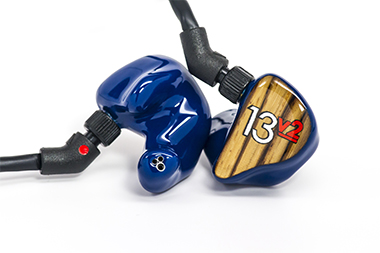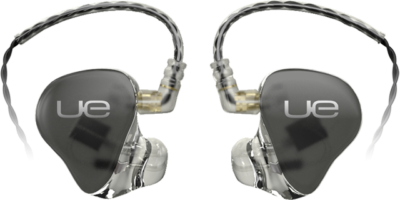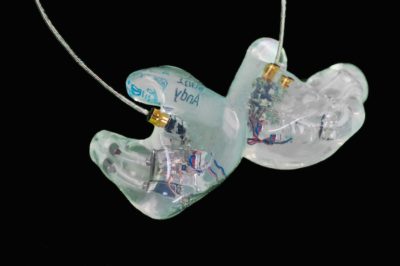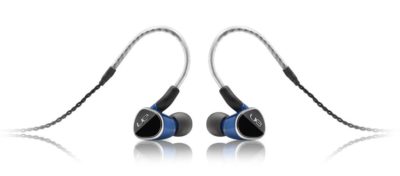In Ear Monitor Buyer’s Guide: Custom vs. Generic Fit
Over the past 20 years, In Ear Monitors (or IEMs) have become a near-necessity for live performance.
In years prior, engineers would inevitably have to crank up a venue’s stage monitors loud enough for the musicians to hear themselves over the audience, over the sound coming from the stage, and over the main mix.
This would often lead to an arms race of ever-increasing stage volume, potentially causing feedback issues and compromises in clarity and quality for the live mix.

Custom in-ear monitors from JH Audio, one of the first commercial brands to make a name for itself in the IEM market.
With the advent of in-ear monitors, all this began to change. In the mid-1980s, Etymotic developed the first-ever insert-style earphones, and soon after, a designer named Marty Garcia began making one-off custom in-ears for rock stars like Todd Rundgren.
By 1995, Jerry Harvey, founder of Ultimate Ears and JH Audio, brought some of the first commercially-available dual-driver IEMs to market. All of a sudden, everyday musicians had an option that allowed us to save our hearing, get better monitor mixes, and dramatically reduce the chances of feedback onstage.
Today, IEMs are increasingly being considered useful tools for the studio as well. Their ability to prevent sound leakage can be of tremendous value in helping to control click and instrument bleed, and in saving musicians’ hearing by allowing them to monitor at lower levels.
Some musicians and engineers, such as drummer Rich Pagano of The Fab Faux, will use IEMs to quickly check for phase when mic’ing up a drum kit, while others turn to IEMs as a kind of audio microscope, using them to help check for and remove extraneous low-level noise.
Any modern musician would be wise to consider adding in-ear monitors to their toolkit. But is it worth it to dish out the extra money on custom fit IEMs, instead of saving some money with the generic fit ones?
In testing a variety of in-ear monitors from brands like Westone, Ultimate Ears, Future Sonics, and even Skullcandy (that last of which is not recommended for professional use), I have found that there are cases in which generic fit earphones may work better than their custom counterparts. Making the right decision for your needs comes down to considering the following four factors:
1) Cost
Custom fit IEMs tend to cost more than generic fit ones, as it takes more time and effort for the manufacturer to craft a product designed specifically for the unique anatomy of your ear.
Getting custom IEMs made also requires that you go to an audiologist to make a mold of your ear canal that the IEM company can then use to make your monitors fit as well as possible.
Take note of both of these costs, which can range from $100-$200 or more for a fitting from an audiologist, and $299-$1499 or more for the custom monitors to be made.
2) Comfort & Seal
Custom fit IEMs are custom, so they should feel really comfortable, right? Well, yes and no.
In my experience, custom fit IEMs can feel a little tight in the ear canal compared to generics, especially at first. Hearing so little acoustic feedback from your performance can also take some getting used to, and the tight seal of custom fit in-ears can feel particularly awkward when signing.
Because of this, my looser-fitting Westone 3 generic IEMs actually feel more comfortable to me on vocal duties, so I often find myself using them over my custom fit Future Sonics when I step up to the mic.
Matt Bellamy from Muse (recently featured in Get THAT Guitar Tone) has been seen using both custom Ultimate Ears UE-11s and generic-fit Westone UM2s when on tour, and my guess is that he has similar reasons.
Though the tight fit of custom IEMs and lack of acoustic feedback from your performance can be a challenge, it’s worth noting that generic foam-tip IEMs also provide their own tradeoffs: The looser fit of generics can sometimes create a bit of a tingling or “tickling” feeling in your ear when playing at higher volumes, so it may be useful to have a pair of each and go with what feels best depending on the date and venue.
Another option here is the custom fit brand ACS, which makes its IEMs out of soft silicone shells.
This softer silicone-based design is meant to offer both better comfort and a tighter fit than the hard acrylic shells used by brands like Westone and Ultimate Ears.
Though these silicone monitors sell for a premium price of $400-$1,200 and up, they may help bridge the gap between the tight seal of custom acrylics and the looser and easier fit of foam-tipped generic IEMs.
3) Hearing Protection
In addition to cutting down on sound leakage to help improve sound quality and reduce feedback, another primary benefit of IEMs is that they can offer considerable hearing protection by helping to block out exterior noise, allowing you to monitor at lower levels.
Some of the best custom fit brands like JH Audio and Ultimate Ears offer NRR ratings of 26dB in reduction, and some of the better generic brands advertise comparable results as well. (Though your results with generics may vary depending on the fit and seal in your ear.)
In the long term, reducing the levels you’re regularly exposed to—even by a few extra decibels—could mean the difference between a long and illustrious career as a “golden-eared” audio engineer and potential tinnitus and irreversible hearing loss.
Also worth checking out is the REV33 system, which can be added on to your your in-ear-monitoring system to help reduce distortion and ear strain. Many live musicians, including Phil X and Steve Salas swear by the system. According to the company:
“All in-ear monitors and headphones generate damaging, unwanted noise and distortion that forces the ear to shut down and compress for protection. The REV33 reduces the symptoms of tinnitus, ear-ringing, ear-fatigue, buzzing and dampened hearing by preventing in-ear monitors and headphones from producing this unwanted noise and distortion.”
4) Waiting and Time Considerations
After getting my first pair of IEM’s made, I found that the right ear monitor turned out well, but I was not getting a proper seal in the left ear at first. This made the monitors essentially useless for my live sound needs at the time, and so I had to send them back for some tweaking.
When I got them back a couple of weeks later, the seal still wasn’t great, so I had to send them back once again for further modification, and visit my audiologist a second time to take another impression of my ear canal to send in.
Getting the perfect fit turned out to be quite a time-consuming process (as well as an expensive one) so unless you’re on the hunt for a long-term solution with as much acoustic isolation as humanly possible, you might satisfice with generic IEMs, or keep some around as an alternate option.
In that case, I would recommend the generic in-ears from Ultimate Ears, Shure, or Westone.
The Ultimate Ears UE900’s are a great sounding 4-driver IEM that only costs $399, while the $99 Shure SE215 single-driver IEMs advertise an astonishing 37dB of noise reduction (more than most custom IEMs) at a great price.
My own triple-driver Westone 3’s (since replaced by the W30 model) are the most comfortable in ear monitors I own right now, and they isolate a lot more noise than most thanks to their foam-tip construction.
Compared to custom in-ears, any of these model can potentially save you time and money, or work as a welcome supplement for those times when the tight fit of custom in-ears feels irksome.
I hope my experiences here help you make the right decision when you go to buy your own IEMs. In short, I found that less-expensive generic foam-tipped IEMs worked better for me in many situations, and the savings enabled me to spend my money on better drivers with a fuller sound.
If you’ve used IEM’s in the past, let us know in the comments below whether you prefer custom fits or generic fit ones, and why.
This story was updated shortly after publication to acknowledge the contributions made by both Etymotic and Marty Garcia in helping to develop IEMs.
Please note: When you buy products through links on this page, we may earn an affiliate commission.










Carolynn Travis
May 12, 2016 at 4:00 pm (9 years ago)You missed the very first in ear and a golden standard for the past 20+ years, the ER-4 by Etymotic. Each channel is hand matched and it has the flattest response on the planet. The non custom tips in various sizes seal the ear and give 25dB of hearing protection. It is easily customizable and retails for $299.
Justin C.
May 12, 2016 at 11:51 pm (9 years ago)Thanks for the addition Carolynn. Etymotic make some great stuff, and we’ve already reached out to them for a future story on custom hearing protection options, as well as an even more geeky story that will take more detailed look at custom in-ear monitoring options specifically. We’re hoping to get some review samples from them for a series of side-by-side comparisons and tests.
Carolynn Travis
May 13, 2016 at 7:20 am (9 years ago)I love the sound of the ER-4. I used them for DJ’ing when I still had my hearing. I own Earlove.net, a hearing protection company have been a hearing protection advocate since 2004 when I lost my hearing. Another place to reach out to for your custom hearing protection article would be RK Audiology in Austin. They fit musicians from across the country with custom hearing protection and have definite opinions about the different brands available, the materials they like, etc. I know they use ER filters in addition to others and would be a great unbiased source of information.
Justin C.
May 13, 2016 at 2:17 pm (9 years ago)Thanks Carolynn. We’ll check them out! We plan to continue in doing a whole series of stories in the future that dive deeper into custom hearing protection, custom IEMs, generic hearing protection, and generic IEMs respectively.
We have a writer working on a story about hearing protection options right now. If you’d like to send her some samples from the Earlove line, just email me at justin [at] sonicscoop and I’ll be happy to put you in touch.
Julie Glick
August 30, 2016 at 11:17 pm (8 years ago)Happy to help anyone in making this decision- we have demo units of JH Audio, UE and Sensaphonics products so you can hear them before they are customized
http://www.musicianshearingsolutions.com